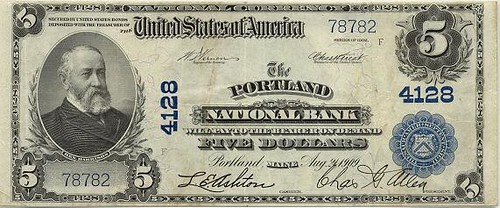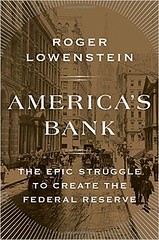
PREV ARTICLE
NEXT ARTICLE
FULL ISSUE
PREV FULL ISSUE
MONETARY BABEL: CREATING AMERICA'S BANK
Last week Pablo Hoffman introduced us to the Delanceyplace newsletter. This week it features another reading selection relating to
numismatics. Here's an excerpt. -Editor
Today's selection -- America's Bank by Roger Lowenstein. On the eve of the American Civil War, there was no single currency in the United States as exists today. Instead, there were thousands of different types of currency in circulation: "In 1858, the United States was an industrializing nation with a banking system stuck in frontier times. ... Heated battles over 'the money question' came to dominate the country's politics, but no matter how unsatisfied the people, any solution that tended toward centralization was, due to the prevailing prejudice, off the table. "America was a monetary Babel with thousands of currencies; each state regulated its own banks and they collectively provided the country's money. Officially, America was on a hard-money basis, but the amount of gold in circulation was insignificant. In any event, as a contemporary would write, it was impractical for a traveler 'to carry with him the coin necessary to meet his expenses for a protracted journey.' If he traveled with notes of any but a few of the biggest banks in New York, Boston, and Philadelphia, his money was likely to be refused, or greatly discounted. If he did carry gold, then, 'at the hotel, in the railroad car, on the river or lake,' he would be offered slips of engraved paper that, in the words of a western banker, might include 'the frequently worthless issues of the State of Maine and of other New England States, the shinplasters of Michigan, the wild cats of Georgia, of Canada, and Pennsylvania, the red dogs of Indiana and Nebraska, the miserably engraved notes of North Carolina, Kentucky, Missouri and Virginia, and the not-to-be-forgotten stumptails of Illinois and Wisconsin.' 
"In theory, these notes were redeemable in gold or in state bonds, but notes from western banks were notoriously unreliable. Bankers, not surprisingly, sought to circulate their paper as far as possible from the point of issue. That way, the notes might never -- or not for a very long while -- return, and the bank avoided the annoying detail of having to redeem its debts. There was no institution to regulate either the quality or the quantity of money, and after states adopted so-called free banking, a promoter needed little more than a printing press to set up shop. In 1853, Indiana's governor lamented, ' The speculator comes to Indianapolis with a bundle of banknotes in one hand and the stock in the other; in twenty-four hours he is on his way to some distant point of the union to circulate what he denominates a legal currency, authorized by the legislature of Indiana.' The system was certainly democratic -- almost anyone could issue 'money' -- but it was just as certain to lead to credit booms and inevitable busts. "According to Jay Cooke, a Philadelphia financier, some banks issued notes equal to twenty-five times their capital 'with no other security than the good faith of their institution.' Since such faith was often short-lived, Cooke hardly needed to add, 'confusion ... was the order of the day.' During the Civil War, the Chicago Tribune counted 1,395 banks in the Union states, each with bills of various denominations -- some 8,370 varieties of notes in all. Even for the careful bank teller, scrutinizing this profusion of paper became an almost hopeless task. In addition to bank failures, the country was plagued by con men whose note forgeries could be worthy of a Rembrandt. So widespread were phony notes that 'Counterfeit Detectors' were published, and these guides were widely circulated. 
Love that Naramore sheet! -Editor
To read the complete article, see:
Wayne Homren, Editor The Numismatic Bibliomania Society is a non-profit organization promoting numismatic literature. See our web site at coinbooks.org. To submit items for publication in The E-Sylum, write to the Editor at this address: whomren@gmail.com To subscribe go to: https://my.binhost.com/lists/listinfo/esylum All Rights Reserved. NBS Home Page Contact the NBS webmaster 
|
